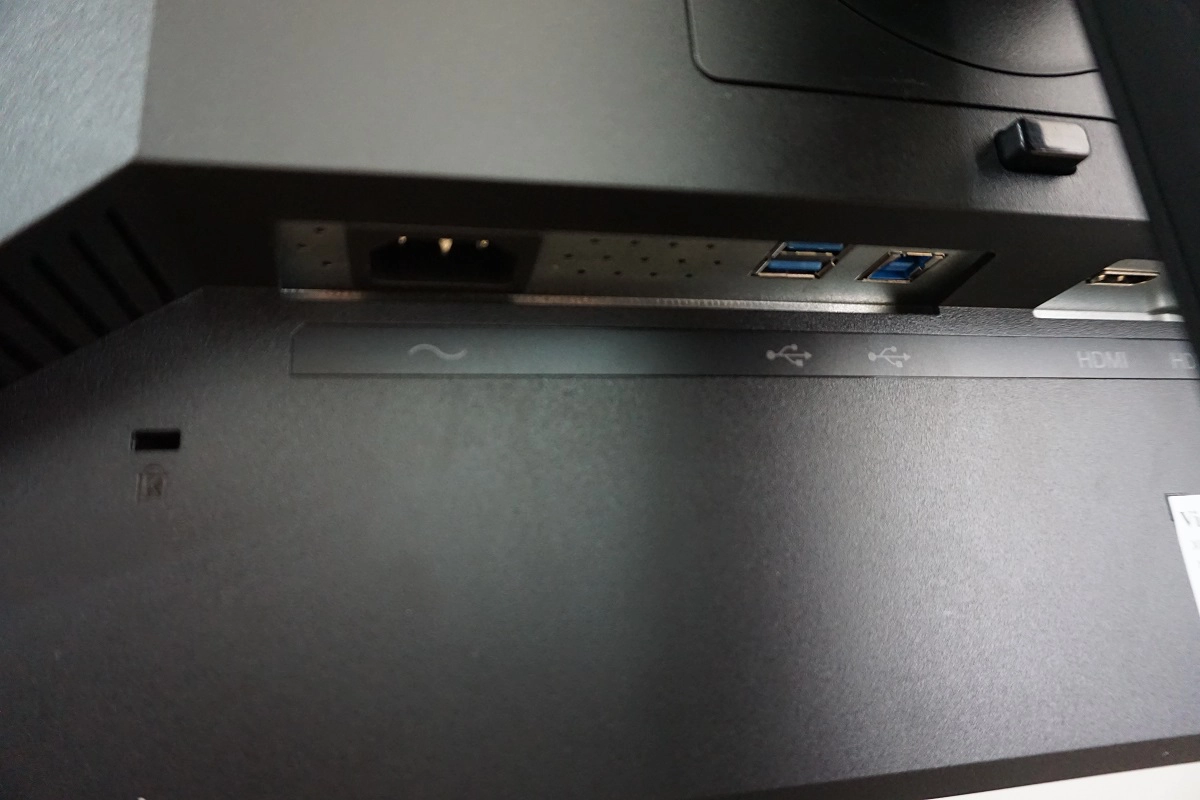Author: Adam Simmons
Date published: January 16th 2018
Table of Contents
Introduction
For gamers looking for a responsive gaming monitor that puts the panel it uses to good use, the ViewSonic XG2401 in one of our go-to recommendations. The ViewSonic XG2402 marks an evolution of this product, with some new features and greater flexibility in terms of image settings. The same 144Hz panel is used, as is the case with pretty much any 144Hz model of this size these days, but there is of course more to a monitor than just the panel. We take a look at the new features and see how the monitor fares in our usual gauntlet of ‘real-world’ tests.
Specifications
The monitor uses a 24” 144Hz TN panel from AUO. This sports 8-bit colour (6-bit + FRC dithering) and has a specified grey to grey response time of 1ms. Take with the usual dose of salt. Some of the key ‘talking points’ of the monitor have been highlighted in blue below.
This screen identifies itself as a ‘gaming monitor’, but does so in a more subtle way than some. There is a vertical red stripe on the stand neck and dark red button labels, but everything else is a fairly subdued matte black. The stand base is notably less deep than its predecessor, with a brushed texture for most of the top surface accompanied by a shiny silver and red ‘XG’ logo to the right. The bezels are moderately thick compared to some models, but they are single-stage and cover the panel border almost entirely. They’re ~17mm (0.67 inches) at the top and sides and ~23mm (0.91 inches) at the bottom. The screen surface is ‘regular’ (medium) matte anti-glare, as explored shortly. From the side the monitor has a reasonably slim profile, particularly for a model with internal power converter; ~18.5mm (0.73 inches) at thinnest point, with more central bulk. You can see the fairly robust and ergonomically flexible stand from the position. The included stand attaches centrally via 100 x 100mm VESA and can be removed to make way for an alternative VESA-compatible solution. The stand allows the following adjustments; tilt (20° backwards, 5° forwards), swivel (45° left, 45° right with a turntable at the base of the neck), height (120mm or 4.72 inches) and pivot (90° clockwise rotation into portrait). At lowest stand height the bottom edge of the monitor clears the desk by ~77mm (3.03 inches), with the top edge ~416mm (16.38 inches) above the desk. The total depth of the monitor including stand is ~235mm (9.25 inches), meaning it can be pushed reasonably close to the wall if required. The image below is a macro photograph taken on Notepad with ClearType disabled. The letters ‘PCM’ are typed out to help highlight any potential text rendering issues related to unusual subpixel structure, whilst the white space more clearly shows the actual subpixel layout alongside a rough indication of screen surface. A ‘regular’ (medium) matte anti-glare surface is used on this screen. This provides strong glare handling, whilst diffusing light emitted from the monitor quite strongly as well. This affects the vibrancy and clarity potential compared to light matte screen surfaces and gives a moderate degree of graininess to the image. This is apparent when viewing light shades, but as explored later it is not the same sort of heavy or ‘smeary’ graininess that some matte surfaces provide. As shown in the image above, the monitor uses the standard RGB (Red, Green and Blue) stripe subpixel layout. This is the default expected by modern operating systems such as Microsoft Windows and Apple’s MacOS. There is therefore no need to run through the ClearType wizard as a Windows user, although you may want to adjust this according to preferences. As a Mac user there is no need to worry about text fringing from non-standard subpixel layouts, either. The subpixel spacing and shape is normal and no issues were identified in terms of text rendering. The XG2402 features a broad range of presets and other image options that can be selected or tweaked in the OSD. The more basic presets are called ‘View Mode’ settings; ‘Standard’, ‘Movie’, ‘Web’, ‘Text’, ‘MAC’ and ‘Mono’. There are also a range of ‘Gaming Settings’ which offer further customisation offers when selected. There are three fully customisable settings that allow you to tweak everything (‘CUSTOM 1’, ‘CUSTOM 2’ and ‘CUSTOM 3’). There are also some presets that configure these settings in various ways but allow no manual control of them; ‘ColorX’, ‘FPS’, ‘RTS’, ‘MOBA’ and ‘Gaming Lite’. We will not be analysing all of the presets in the table below, but there is some discussion of the key settings available in the ‘CUSTOM’ presets in the OSD video that featured earlier. The table below shows some key readings taken using a Datacolor Spyder5ELITE colorimeter (central gamma and white point). Some general observation on the image is also included alongside the ‘Extra OSD Features’ associated with certain presets or selected options. Our test system runs Windows 10 and has a Club3D Radeon R9 290 royalAce FreeSync-compatible GPU connected via DisplayPort. The monitor was left in its ‘plug and play’ state without additional drivers or ICC profiles specifically loaded. The monitor was left to run for over 2 hours before readings were taken. Aside from for our ‘Test Settings’, assume any settings not mentioned here were left at default. Note that the refresh rate was set to 144Hz as that is the main setting of interest on this monitor, except for where the 60Hz setting is explicitly mentioned for one row of the table. We also tested the monitor using an Nvidia GTX 1070 via both DP and HDMI to make sure there weren’t any specific issues there. There weren’t and our observations for this table were much the same. When viewing the figures in this table, note that for most PC users ‘6500K’ for white point and ‘2.2’ for gamma are good targets to aim for.
As an Amazon Associate I earn from qualifying purchases made using the below link. Where possible, you’ll be redirected to your nearest store. Further information on supporting our work.
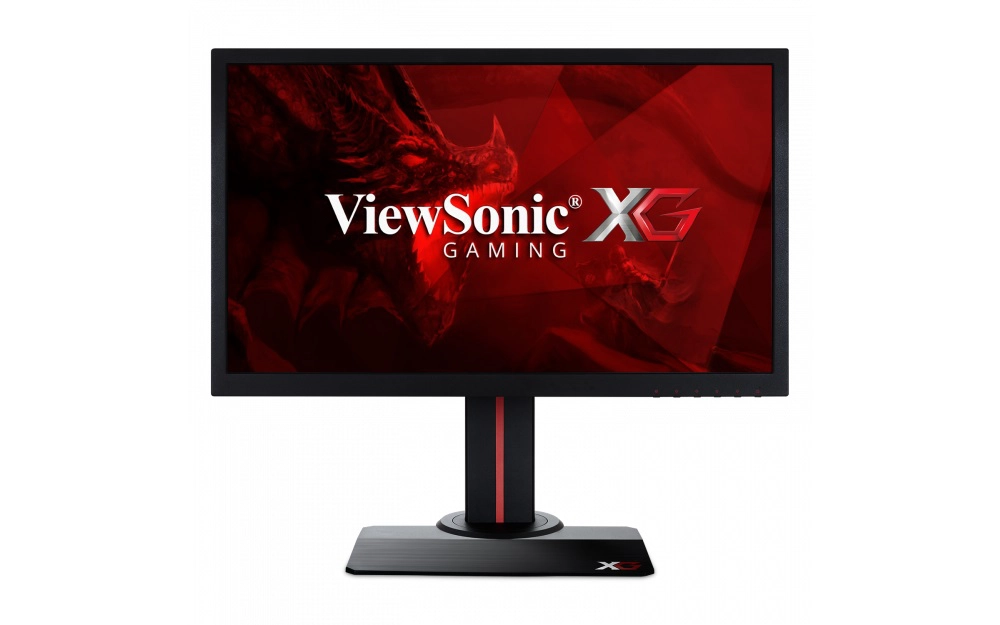
Features and aesthetics
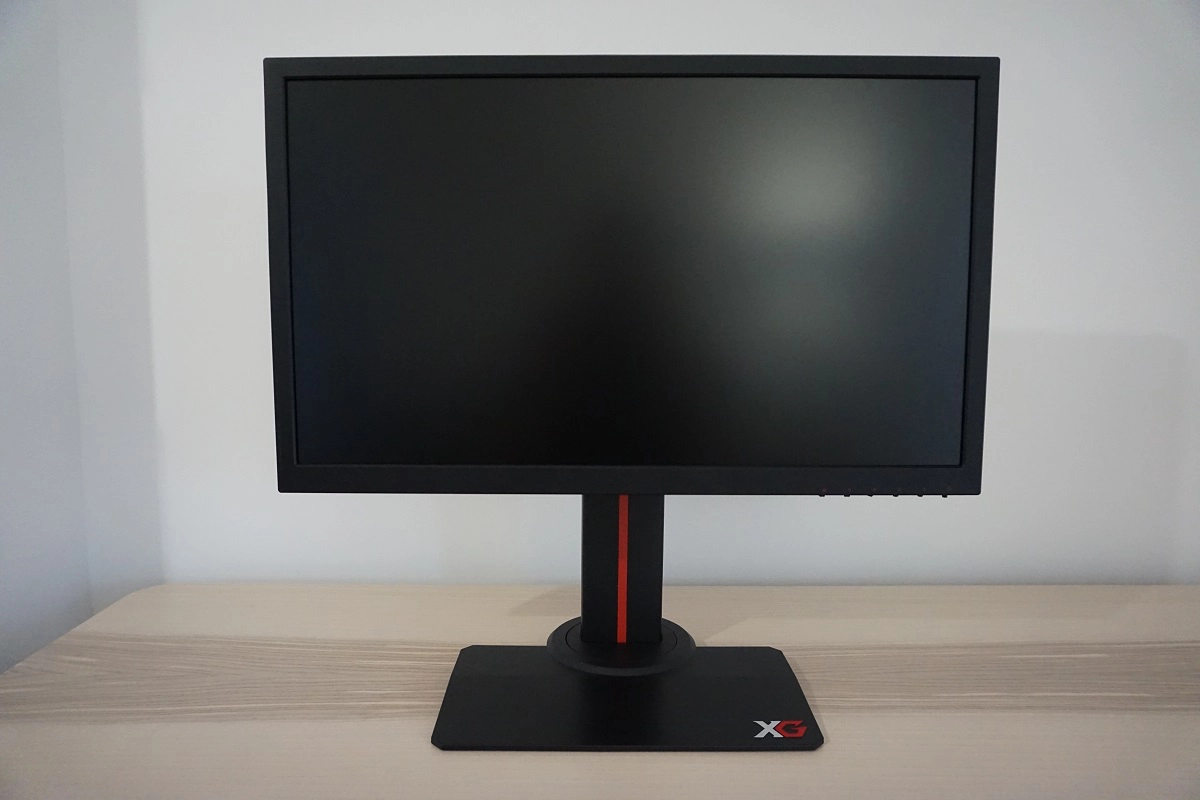
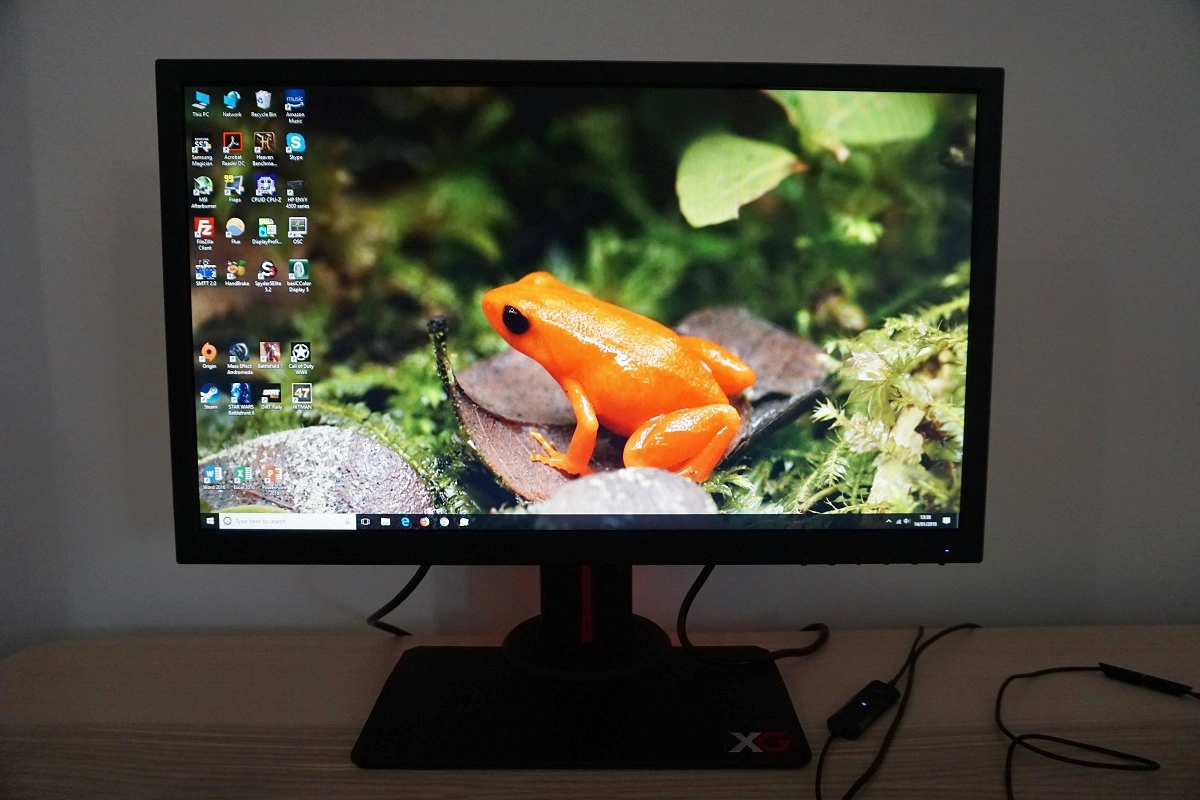
The OSD (On Screen Display) controls are pushable buttons which face downwards, located towards the right side of the monitor. The button labels are lightly coloured red, facing forwards. There is a small pinpoint style forward-facing power LED above the power button. This glows blue when the monitor is on and orange when it’s in a low power state (loses signal to the PC). The video below runs through the OSD, which as you can see is considerably more feature-rich than on the previous model.
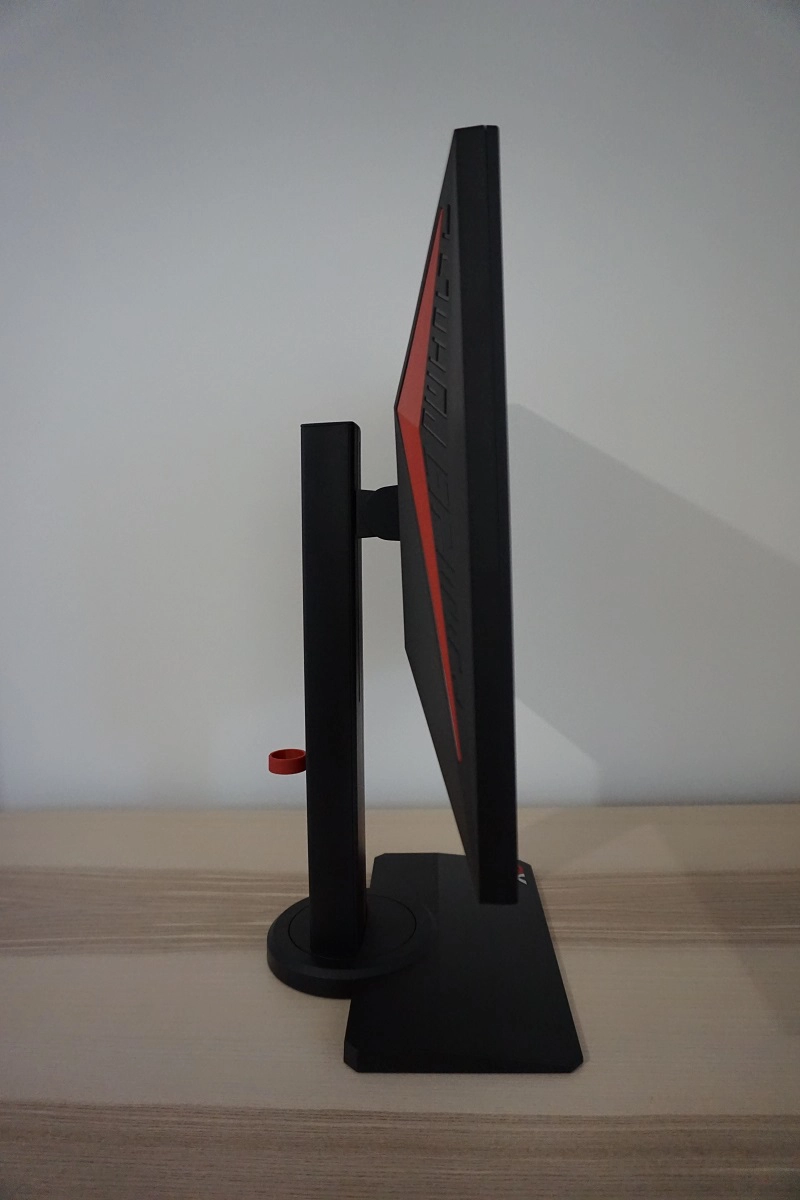
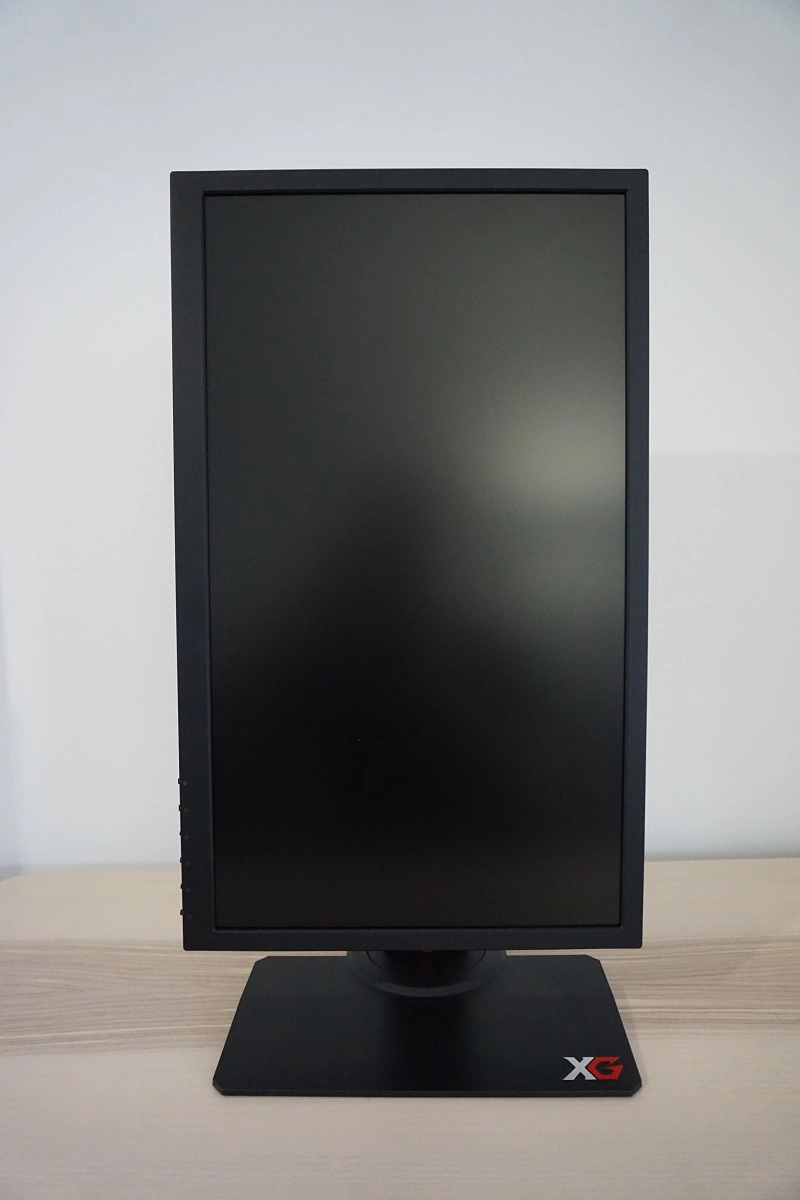
The rear of the monitor is mainly matte black plastic, with some red elements. Most notably there are two inwards-facing chevrons at either side of the screen, which can be set to glow red in the OSD. These have LEDs integrated into them, something that ViewSonic calls ‘Rampage X Lighting’. This feature is shown in the OSD video. There is also a dark red vertical stripe down the stand neck, a red ViewSonic logo and a red cable-tidy loop. At the top of the stand neck there’s a retractable headphone hook, not a particularly wide one but just enough to help keep even fairly substantial gaming headphones in place at the rear of the monitor. There is a K-Slot towards the bottom left, beneath one of the chevrons and integrated 2 x 2W speakers for basic and fairly mediocre sound output. The ports are down-firing and include; AC power input (internal power converter), 2 USB 3.0 ports (plus upstream), 2 HDMI 1.4 ports, DP 1.2a and a 3.5mm audio output.

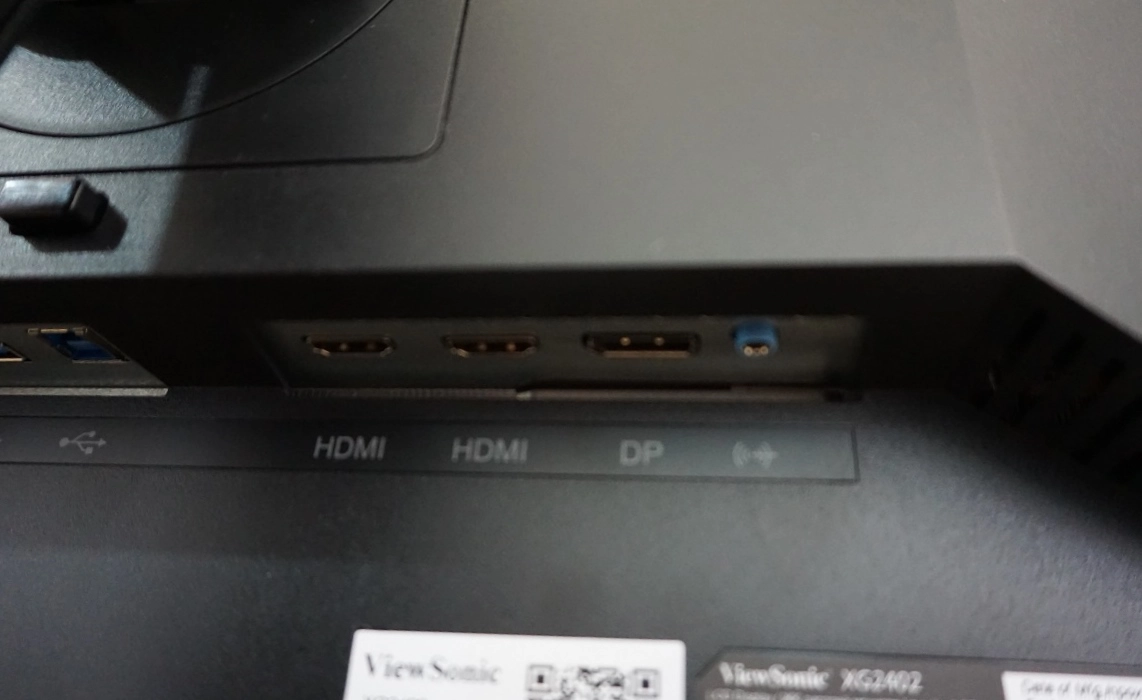
The full 1920 x 1080 @ 144Hz is supported by either DP or HDMI 1.4 on both Nvidia and AMD GPUs. Compatible AMD GPUs also support FreeSync, via DP 1.2a or HDMI. A DisplayPort cable, USB cable and power cable are included as standard accessories in the box.
Calibration
Subpixel layout and screen surface
![]()
Testing the presets
Monitor Settings Gamma (central average) White point (kelvins) Extra OSD features Notes View Mode = Standard @144Hz (Factory Defaults) 1.9 6951K Brightness, Contrast, Color Temperature, Black Stabilization, Blue Light Filter Very bright with a cool-green tint to the image. Things appear fairly bleached (‘washed out’) overall. The usual TN viewing angle related weaknesses apply. From a normal viewing position, things appear darker and more saturated (higher perceived gamma) higher up the screen and lighter and less saturated (lower perceived gamma) lower down the screen. View Mode = Standard @60Hz (Factory Defaults) 2.1 6947K Brightness, Contrast, Color Temperature, Black Stabilization, Blue Light Filter As above but gamma is higher, adding some extra richness to the image. It clearly looks less ‘washed out’. Gamma differences at different refresh rates are quite common on this panel, these can be counteracted with the flexible gamma settings on this model. Gamma = 1.8 1.6 6952K Brightness, Contrast, Color Temperature, Black Stabilization, Blue Light Filter As factory defaults but the image appears even more washed out, completely lifeless. Gamma = 2.0 1.8 6967K Brightness, Contrast, Color Temperature, Black Stabilization, Blue Light Filter As factory defaults but slightly weaker saturation due to marginally reduced gamma. Gamma = 2.4 2.1 6986K Brightness, Contrast, Color Temperature, Black Stabilization, Blue Light Filter As factory defaults but image approaching appropriate richness overall, with better saturation and a livelier look. Gamma = 2.6 2.3 6996K Brightness, Contrast, Color Temperature, Black Stabilization, Blue Light Filter As above with a touch more richness. Gamma = 2.8 2.5 7000K Brightness, Contrast, Color Temperature, Black Stabilization, Blue Light Filter As above, even deeper. Some shades appear significantly deeper and somewhat more saturated than they should, particularly when those shades are observed higher up the screen where perceived gamma is even higher. Color Temperature = sRGB 1.9 6913K Similar to factory defaults but significantly dimmer. Color Temperature = Warm 1.9 5630K Brightness, Contrast, Black Stabilization, Blue Light Filter A Low Blue Light (LBL) setting, significantly warmer than factory defaults. Fairly effective blue light reduction, suitable for relaxing evening viewing. Color Temperature = Full Color Control 1.9 6880K Brightness, Contrast, Dynamic Contrast, Blue Light Filter Similar to factory defaults but green tint weakened (remains cool in tone) and slightly brighter. Blue Light Filter = 100 1.9 4960K Brightness, Contrast, Dynamic Contrast, Blue Light Filter The most effective LBL setting, cutting down blue light significantly and giving a much warmer appearance to the image (your eyes eventually adjust to this to an extent). This is a good setting to use before bed or other times where blue light exposure should be minimised to aid relaxation. Gaming Settings = ‘CUSTOM 1’ 2.2 7121K Brightness, Contrast, Black Stabilization, Blue Light Filter, Gaming Settings (refer to OSD video) Slightly dimmer and cooler in tone than factory defaults. Image appears richer and has a little bit of oversaturated and shade crushing. This is due to the modified ‘Gamma’, ‘Saturation’, ‘Contrast’ and ‘Black Stabilization’ settings used by default on ‘CUSTOM 1’, but they can be manually adjusted. Test Settings 2.2 6497K Brightness, Contrast, Black Stabilization, Blue Light Filter, Gaming Settings (refer to OSD video) The image is richer and better balanced than factory defaults. The aforementioned TN weaknesses still apply, of course, but the image looks richer than on some competing models regardless of the OSD settings used. This model does not require the intervention of an ICC profile thanks to the flexibility offered in the OSD.
Out of the box the image appeared fairly washed out, overly bright and cool-tinted (not in a good way). With some models, particularly those using this panel, you can tweak the OSD all you like and can improve on some areas. But you’re sometimes left with poor average gamma that saps the image of much-needed depth. The monitor might tease you by offering superior gamma tracking and richness at 60Hz, but not at higher refresh rates such as 144Hz that these models are really designed to run at. Whilst this model did tease in such a way, it also provided the necessary flexibility in the OSD to rectify the gamma tracking issue at 144Hz. This is important due to the known inconsistencies with this panel, at different refresh rates but also between units of the same model. Even some XG2401 units (this model’s predecessor) had issues with average gamma and no way to correct this properly in the OSD. The ‘Gamma’ settings provided good flexibility, but if you’re wanting to increase gamma just slightly without going as high as the next gamma mode, you can do that as well. If you nudge the ‘Black Stabilization’ slider down just a bit (the default is ‘11’) you will slightly increase average gamma without upsetting the image in other areas. The graph below shows the gamma tracking for our unit under our ‘Test Settings’ – no ICC profile necessary (or provided by us) for this model. As shown in the table there are also a range of Low Blue Light (LBL) settings available on this model. The most flexible and clearly effective of these is the ‘Blue Light Filter’ option, adjustable in single unit increments from ‘0’ (off) to ‘100’ (full effect). The ‘Blue Light Filter’ overrides any other changes made to the colour channels, in the ‘Color Temperature’ section of the OSD for example. We prefer to quickly activate an LBL setting for relaxing evening viewing, where blue light output should be cut down to avoid disrupting sleep, and deactivate for our testing or during the daytime. For this we duplicated our settings for ‘CUSTOM 1’ (i.e. ‘Test Settings’) onto ‘CUSTOM 2’ except for applying a strong ‘Blue Light Filter’ setting – you can even rename the ‘CUSTOM’ settings in the OSD so that it is quite clear what they’re intended for. For our ‘Test Settings’ we used ‘CUSTOM 1’ and made various adjustments. AMD FreeSync was activated in the OSD for our main test system, which uses an AMD GPU (Radeon R9 290). With an Nvidia GPU (GTX 1070) in the system we could still access this option, but it didn’t do anything useful. We found all of the other settings worked in much the same way using our Nvidia GPU. Note that individual units can vary and so do personal tastes, so these settings won’t necessarily be optimal and are just intended to be used as a guide. Anything not mentioned was left as default for ‘CUSTOM 1’ – we’ve also included the refresh rate used in Windows just for reference. Rampage Response= Fast Black Stabilization= 11 (higher reduces contrast, too much lower noticeably eats away at dark detail) Brightness= 38 (according to preferences and lighting) Contrast= 70 Color Saturation= 50 Gamma= 2.6 AMD FreeSync= On Color Temperature= Full Color Control R= 100 G= 90 B= 92 Refresh rate (Windows setting)= 144Hz We used a BasICColor SQUID3 (X-Rite i1Display Pro) to measure the luminance of black and white using a range of settings. From these values, static contrast ratios were calculated. The table below shows this data. Blue highlights indicate the results under our ‘Test Settings’, whilst black highlights indicate the highest white luminance, lowest black luminance and highest contrast ratio recorded. Assume that any setting not mentioned was left at default, with the exceptions already mentioned in the calibration section.
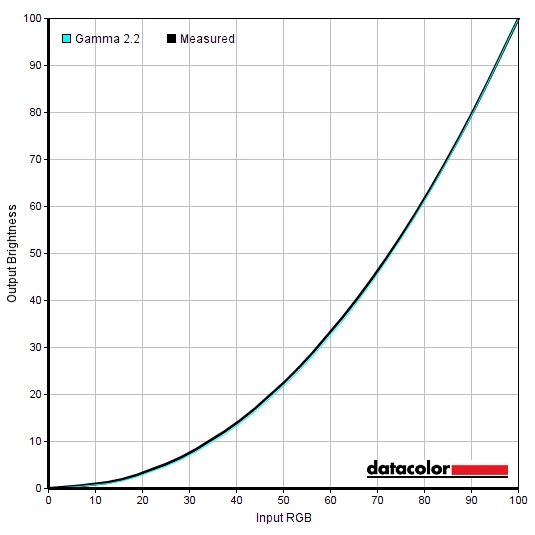
Gamma 'Test Settings'
Test Settings
Gaming Settings= CUSTOM 1
Contrast and brightness
Contrast ratios
Monitor Settings White luminance (cd/m²) Black luminance (cd/m²) Contrast ratio (x:1) 100% brightness (Factory Defaults) 356 0.61 584 80% brightness 299 0.48 623 60% brightness 246 0.39 631 40% brightness 192 0.31 619 20% brightness 137 0.23 596 0% brightness 84 0.15 560 View Mode = Standard @60Hz (Factory Defaults) 357 0.49 729 Gamma = 1.8 356 0.61 584 Gamma = 2.0 354 0.61 580 Gamma = 2.4 352 0.61 577 Gamma = 2.6 350 0.61 574 Gamma = 2.8 349 0.61 572 Color Temperature = sRGB 132 0.23 574 Color Temperature = Warm 334 0.58 576 Color Temperature = Full Color Control 371 0.61 608 Blue Light Filter = 100 273 0.5 546 Gaming Settings = ‘CUSTOM 1’ 263 0.51 516 Test Settings 176 0.32 550
The average contrast ratio with only brightness adjusted (@144Hz) on the XG2402 was 602:1, which is disappointing. The contrast ratio was slightly higher when setting the monitor to 60Hz (729:1), but still quite poor really given the panel specifications (1000:1) and what we’ve seen from other models using this panel. Setting the monitor to 120Hz or 100Hz yielded results some way between those values, generally ~630:1 – 650:1. We tested via HDMI (both ports) and DP on both our AMD and Nvidia GPUs and made sure everything was configured correctly in the GPU driver. We also tested various settings not documented in the table, but no improvement was yielded. Under our ‘Test Settings’ a contrast ratio of 550:1 was yielded, which was interestingly quite similar to the full ‘Blue Light Filter’ setting. To put this in context, we measured 994:1 on the older XG2401 using our ‘Test Settings’. It isn’t clear whether this is perhaps an issue with our particular unit; it was the only review sample available, so we couldn’t check another unit. The maximum white luminance recorded on this table was 371 cd/m² and the minimum white luminance was 84 cd/m². This isn’t a particularly low minimum and greatly exceeds the 29 cd/m² of this model’s predecessor, although it should be fine for most users. This gives the monitor a 282 cd/m² luminance adjustment range.
There is also a ‘Dynamic Contrast’ setting that can be activated when using the ‘CUSTOM’ presets. This is called ‘Advanced DCR’ (Advanced Dynamic Contrast Ratio). This allows the backlight brightness to adjust according to the level of light or dark on the screen – the backlight is controlled as a single unit, there is no local dimming used here. No manual brightness adjustment is available with this setting active. It offers some flexibility in that it can be set between ‘0’ (off) and ‘20’ (maximum effect) in increments of 1. However; this doesn’t noticeably impact the maximum or minimum brightness used, it simply increases the level of sharpness up to absurdly over-sharp levels. This is a pointless addition and a poor way of adding ‘flexibility’ to this setting. The backlight seemed to be rather intense even for mixed scenes with plenty of darker shades, although dimmed fairly effectively for predominantly dark content. We don’t like Dynamic Contrast modes at the best of times, but this is just a weird implementation that we’ve seen on a few ViewSonic models now.
PWM (Pulse Width Modulation)
The monitor does not use PWM (Pulse Width Modulation) at any brightness level. DC (Direct Current) is instead used for backlight brightness regulation. The backlight is therefore considered ‘flicker-free’, which will come as welcome news to users sensitive to the side-effects of PWM or who simply prefer to know a flicker-free backlight is used.
Luminance uniformity
Whilst observing a black screen in a dark room, using our test settings, we noticed some backlight bleed and moderate clouding, particularly lower down the screen. This is shown in the image below. Bear in mind that individual units vary when it comes to uniformity issues, including the issues highlighted here such as backlight bleed and clouding. A slight silver or golden sheen (depending on viewing angle) is visible if you view the screen from sharper angles. This is highlighted in the viewing angles video later on. It isn’t anywhere near as obvious as ‘IPS glow’ and can’t be readily observed from a normal viewing position.
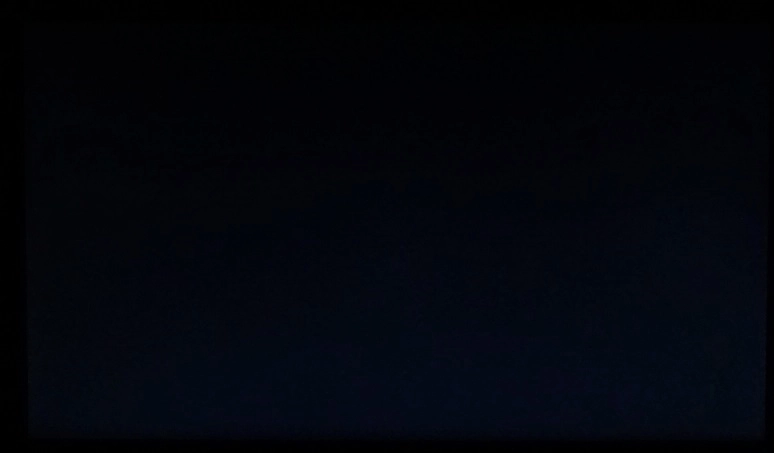
The Spyder5ELITE was used to assess the white uniformity of the monitor, represented by 9 equally spaced white quadrants running from the top left to bottom right of the screen. The table below shows the deviation between each point and the brightest recorded point as well as the percentage deviation between each quadrant and the brightest recorded point. The luminance uniformity was not great. The brightest point recorded was ‘quadrant 5’ in the centre of the screen (169.9 cd/m²). The greatest deviation from this occurred at ‘quadrant 4’ to the left of centre (143.1 cd/m², which is 16% dimmer than centre). Elsewhere deviation was between 6 – 15%, with an overall average deviation between the brightest point and each quadrant of 10.25%. Note that individual units vary in terms of uniformity and that further deviations can be expected beyond the points measured. Also note that the viewing angle limitations of the panel introduce differences in perceived luminance that aren’t accounted for in these measurements, with variation depending on which part of the screen you’re observing. The contour map below shows these deviations graphically, with darker greys representing lower luminance and hence greater deviation from the brightest point than lighter greys. The percentage deviation between each quadrant and the brightest point is also given. Due to the aforementioned viewing angle limitations, we will not be providing colorimeter-based analysis of the colour temperature uniformity of the monitor. The perceived colour temperature can vary significantly depending on which part of the screen you’re observing, from a normal viewing position. Any readings provided here have the potential to be highly misleading. On Battlefield 1 (BF1) the contrast performance was unspectacular. Detail levels in dark scenes were largely appropriate for the central mass of the screen, but the aforementioned perceived gamma changes related to the TN panel came into play. This caused dark shades to appear lighter than intended lower down the screen and relatively dark higher up the screen. Lower down the screen there was therefore some extra unintended detail revealed, whilst further up the screen there was some detail lost due to the dark shades being particularly deep. The relatively weak static contrast exacerbated the lighter than intended look to dark shades lower down the screen. We wouldn’t say things exactly looked ‘flooded’ and there wasn’t the sort of look at ‘IPS glow’ might give in similar regions, but there was a definite lack of depth. Lighter shades stood out reasonably well against darker surroundings, with a bit of graininess from the screen surface visible here as well. On Dirt Rally some of the weaknesses in contrast performance were again apparent. This title features some night scenes that are supposed to be particularly dark and ‘atmospheric’, but the weak static contrast and the perceived gamma behaviour prevented these scenes from having the deep and dark look they crave. This was apparent even in a fairly well-lit room, but more so in a darker room. The level of detail was largely appropriate for dark scenes, though, in that some fairly minor details such as car tread patterns and interior material textures were clearly visible. Further up the screen such detail was masked due to the darker shades appearing very dark and deep with fairly extreme high gamma. This TN weakness is not specific to this model. The brighter shades appeared a bit grainy due to the screen surface, but not in a heavy and ‘smeary’ way thankfully. We made similar observations on the Blu-ray of Star Wars: The Force Awakens. The film was certainly watchable, but it’s full of scenes that combine bright and dark shades. The title lacked the desired atmosphere due to the darkness looking somewhat foggy rather than deep and pure. The level of detail was generally fine, though, and the mid and high end had decent distinctions. Lagom’s tests for contrast were used to more closely analyse contrast performance, highlighting weaknesses in quite a specific way. The following observations were made from a normal viewing position, eyes around 70cm from the screen. The colour gamut of the XG2402 (red triangle) was compared with the sRGB colour space (green triangle), as shown in the image below. The monitor offers decent sRGB coverage (98% measured), with just a little under-coverage in some regions and slight over-coverage in others. This gives the monitor the potential to output a good range of shades within the sRGB colour space, with a touch of extra vibrancy in places – but not as much as seen on models with a more generous colour gamut. On Battlefield 1 (BF1) things looked fairly rich and natural overall. Things didn’t have that flooded and washed out appearance that some competing models have, where gamma is simply too low. There were some decent vibrant reds and oranges displayed when observing roaring fires and some reasonably rich greens for vegetation. Due to the perceived gamma behaviour, shades lost saturation lower down the screen and gained extra saturation further up the screen. These rich shades therefore appeared less vivid than they should lower down the screen. This weakness in colour consistency hampered the apparent shade variety, with a given shade appearing quite different depending on where on the screen it was displayed. Overall this title lacked the ‘pop’ that some monitors with lighter screen surfaces, more generous colour gamuts or more consistent colours can give. But it avoided the unpleasant washed out look offered by some of the competing models with obvious gamma issues. We made similar observations on Dirt Rally. The racing environments looked fairly rich and natural, with some fairly decent lush greens and rich earthy browns. This was more apparent further up the screen, though, as lower down the screen these same shades were sapped of a lot of their depth. Rich earthy browns appeared more clay-like and lush forest greens appeared more faded and dusty. The car liveries lacked the ‘pop’ of some models, but still showed some decent vivid shades such as neon pinks and greens. The appropriate central gamma handling helped in this respect, but a more generous colour gamut and greater colour consistency would also have been beneficial. To round off, we assessed colour reproduction using the Blu-ray of Futurama: Into the Wild Green Yonder. With large areas of individual shades covering a significant portion of the screen, this movie is particularly revealing when it comes to colour consistency weaknesses. Unsurprisingly, the aforementioned shifts in gamma and saturation were readily apparent. Character skin tones, for example, appeared much lighter lower down the screen compared to higher up. They lost their individuality and identity, with a given character’s skin tone varying significantly depending on where on the screen the character was displayed. There were some fairly striking neon shades, although the weaker than ideal contrast meant that some of the deepest shades lacked a bit of oomph. We used Lagom’s tests for viewing angle to analyse colour consistency and viewing angle performance in a more specific way. The following observations were made from a normal viewing position, eyes around 70cm from the screen. Some models exhibit what we refer to as ‘interlace pattern artifacts’, particularly but by no means exclusively those with high refresh rates. These artifacts can also be referred to as ‘inversion artifacts’ or ‘scan lines’. Sometimes static interlacing patterns are visible, whereby shades are broken up into thin (usually vertical) lines that alternate between a slightly lighter and slightly darker than intended variant of the shade. Dynamic interlacing patterns may also be observed, which take many forms and sometimes appear as a sort of mesh, grid or lines or ‘interference’ when you observe motion on the monitor. The XG2402 did not exhibit any noticeable static interlace pattern artifacts, but did exhibit dynamic interlace patterns. If you observed movement on the screen at certain (slow to moderate) paces of action you could see the image appear to break up into a faint mesh pattern. This was a very faint and fine pattern that not everybody would notice and few would find distracting, but we thought we’d mention it for completeness. This occurs regardless of refresh rate, FreeSync or ‘Rampage Response’ setting. The image below is a pursuit photograph taken using the UFO Motion Test ‘Moving Photo’ page and highlights this pattern (see in particular the top left region). Again, note that it’s a very fine and faint pattern in reality. A sensitive camera and a utility called SMTT 2.0 was used to assess the input lag of the XG2402. It was compared with a number of monitors of known latency, with over 30 repeat readings taken to try to maximise accuracy. Using this method we calculated 3.16ms (~ ½ a frame at 144Hz) of input lag. With the monitor running at 60Hz, we calculated 11.74ms of input lag. These values take into account both the element of input lag you ‘see’ (pixel responsiveness) and the element you ‘feel’ (signal delay). It indicates a very low signal delay at 144Hz, which even sensitive users should find absolutely fine. Note that we have no way to accurately measure input lag when FreeSync is doing its thing. Our responsiveness article explores the factors which affect responsiveness of a monitor. Chief amongst these is the concept of ‘perceived blur’, contributed to by both the pixel responsiveness of the monitor and the movement of your eyes as you track motion on the screen. This second factor is generally the dominant contributor to perceived blur on modern monitors. Both aspects of perceived blur can be accurately captured using a photography technique explored in the article; ‘pursuit photography’. This uses a moving camera rather than a static one to capture a snapshot of motion on the screen, giving a good idea of what the eye actually sees at that given moment in time when observing motion on the screen. The images below are pursuit photographs taken using the UFO Motion Test for ghosting, with the test running at its default speed of 960 pixels per second. This is a good practical speed for taking such photographs at and demonstrates both elements of perceived blur nicely. The UFOs move across the screen from left to right at a frame rate matching the refresh rate of the display. The first set of photos shows the results with the monitor set at 60Hz and the second with the monitor set at 144Hz. All three rows of the test (dark, medium and light background) are used to showcase a range of different pixel transitions. The full range of ‘Rampage Response’ (pixel overdrive) settings are also tested – this can be selected in the ‘CUSTOM’ presets as noted earlier. For 60Hz and 144Hz a capture from a reference monitor is shown, namely the Dell S2417DG, giving an indication of what things look like without pixel responsiveness really being a limiting factor. We’ve also included the older ViewSonic XG2401 as a 144Hz reference, running with its optimal pixel response time setting. The images above were captured with the monitor set to 60Hz. The UFO appears broad and quite blurry, indicating a moderate amount of perceived blur due to camera (eye) movement. Behind the UFOs you can see varying degrees of trailing, caused by suboptimal pixel responses. There is a bit of a powdery trail behind the object using the ‘Standard’ setting. This is reduced significantly using the ’Fast’ setting, which brings things in-line with the reference shot. The ‘Faster’ setting slightly reduces the trailing again, although this is marginal. It also introduces a small amount of overshoot (inverse ghosting), visible most clearly for the dark background (top row) as a slightly darker trail behind the UFO cockpit. It’s still very faint in this example. The ‘Ultra Fast’ setting makes the overshoot a bit more pronounced, but by no means extreme. It eliminates any conventional trailing behind the UFO with the dark background. The ‘Fastest’ setting, meanwhile, introduces far more obvious overshoot with brightly coloured trailing behind the object for the dark and medium backgrounds in particular. Given that ‘Fast’, ‘Faster’ and ‘Ultra Fast’ all perform well at 60Hz, it’s likely users will find any of these settings to be decent. The tolerance to a small amount of trailing vs. a small amount of overshoot may be the deciding factor. Note that the overshoot was a bit more obvious for some transitions not shown here, even with the ‘Faster’ setting. With the refresh rate increased to 144Hz, as shown above, the perceived blur is massively reduced. The UFO appears narrower and more sharply focused, with crisper details. There is again some trailing behind the object in places due to suboptimal pixel responses, although this is generally very slight. With the ‘Standard’ setting you can see a faint powdery trail behind the object, particularly for the dark and medium backgrounds. This is similar to the XG2401 reference shot when using its ‘Standard’ response time setting which we consider optimal on that model. The ‘Fast’ setting reduces this trailing significantly, so it is as good as non-existent. There is just the faintest hint of it, for example behind the UFO body with the dark background. There is also a tiny amount of overshoot behind the UFO with the lightest background, appearing as a very faint (barely perceptible) shadow. The ‘Faster’ setting intensifies this overshoot slightly, most noticeably for the dark background. The very small hint of conventional trailing there is replaced with overshoot. The ‘Ultra Fast’ setting increases the overshoot without bringing any visible benefits, whilst the ‘Fastest’ setting brings with it rather intense overshoot. Obvious bright and colourful trails are present behind the object. From this analysis it would seem that ‘Fast’ is optimal, with ‘Faster’ also a decent bet. In practice we found both settings quite similar, although did notice the slightly increased overshoot in places for ‘Faster’ without noticing any benefits. We therefore settled for ‘Fast’ during our testing, which is very well optimised indeed and as good as we’ve seen from any 144Hz model really. Note: The ‘Monitor Hertz Cap’ did not function correctly on either the AMD or Nvidia GPU we tested. It did not change the Windows (or graphics driver) setting and instead simply caused obvious frame skipping and a generally uncomfortable experience if set to something lower than what Windows was set to. This sort of setting would be useful if it actually changed the refresh rate properly, but that didn’t seem to be the case. You can leave this at ‘Native(144Hz)’ and select any refresh rate available in Windows, your graphics driver or in-game without issue. On Battlefield 1 (BF1) responsiveness was excellent, where the frame rate kept up with the 144Hz refresh rate. With the monitor pumping out up to 2.4 times as much visual information every second as a 60Hz monitor, there was a definite precision and fluidity when interacting with the game. This is something we like to call ‘connected feel’, and it was further aided by the very low latency of this monitor. The refresh rate also significantly reduced perceived blur, which was complimented very well by extremely snappy pixel responses. As demonstrated in the pursuit photographs earlier, there was very little to speak of in the way of trailing or overshoot – it was a very ‘clean’ 144Hz performance. This was true across the broad range of transitions on this title, meaning that the level of perceived blur was about as low as you’ll see on a 144Hz sample and hold monitor, without any nasty distractions. There was the smallest trace of faint overshoot and powdery trailing here and there, but even when we were specifically looking out for it we didn’t find it obvious. This low level of perceived blur helped make tracking and engaging enemies that bit easier and made it much easier to focus on the game world during rapid movements than on 60Hz models. Some users would very much appreciate the competitive edge that this can bring, whilst others would simply find it a more enjoyable or even comfortable way of playing. On Dirt Rally the consistently strong pixel responses were again demonstrated. The track and elements of the environment retained superior clarity during sharp cornering or even more gentle manoeuvring, making the experience more pleasant and less dizzying than on a 60Hz model. Whilst the low latency was ‘nice’, we didn’t find it as beneficial as on FPS titles such as BF1. That says more about the level we play this sort of game at – we’re keyboard and mouse rookies. If you’re really into racing games and have an appropriate controller, you’d find the snappy responses to user input and the excellent fluidity of the experience very enjoyable. We also tested our Blu-ray test titles and didn’t find any weaknesses in the monitor’s performance. The ~24fps at which the titles run severely limited their visual fluidity and also the required speed of pixel responses. Even so, no weaknesses such as obnoxious overshoot, trailing or after images were observed. The fact that this frame rate divides neatly into the refresh rate (144Hz) also helped. The monitor can also be set to run at various static refresh rates that might match some other content, including 25Hz, 30Hz and 50Hz. As an Amazon Associate I earn from qualifying purchases made using the below link. Where possible, you’ll be redirected to your nearest store. Further information on supporting our work. AMD FreeSync is a variable refresh rate technology, an AMD-specific alterative to Nvidia G-SYNC. With this technology, the monitor adjusts its refresh rate dynamically, where possible, to match the frame rate being outputted by the GPU. Both the responsiveness article and the G-SYNC article linked to previously explore the importance of these two elements being synchronised. Essentially, a mismatch between the frame rate and refresh rate can cause stuttering (VSync on) or tearing and juddering (VSync off). An additional benefit of FreeSync is reduced latency compared to running with VSync on, within the variable frame rate environment in which it operates. FreeSync requires a compatible AMD GPU such as the Club3D Radeon R9 290 royalAce used in our test system. There is a list of GPUs which support the technology here, with the expectation that future AMD GPUs will also support the feature. The monitor must support ‘VESA Adaptive-Sync’ for at least one of its display connectors, as this is the protocol that FreeSync uses. The XG2402 supports FreeSync via DP 1.2a (‘DP 1.2a+’) as well as HDMI on compatible GPUs. AMD’s recent drivers include Radeon Settings, which makes activation of the technology very simple. It should be automatically enabled once the monitor is connected and ‘AMD FreeSync’ is set to ‘On’ on the ‘Gaming Settings’ section of the OSD. You can check its status by opening ‘AMD Radeon Settings’ and clicking on ‘Display’. You should then ensure that the first slider, ‘AMD FreeSync’, is set to ‘On’. If you hover over this, it will also report the variable refresh rate display supported by the display. Note that the image below is for a different monitor and is just used as an example here. VSync is configured in the ‘Gaming’ section of ‘Radeon Settings’, where it is referred to as ‘Wait for Vertical Refresh’. You can either configure this globally under ‘Global Settings’ or for each game individually. The default is ‘Off, unless application specifies’ which means that VSync will only be active if you enable it within the game itself, if there is such an option. Such an option does usually exist – it may be called ‘sync every frame’ or something along those lines rather than simply ‘VSync’. Most users will probably wish to enable VSync when using FreeSync to ensure that they don’t get any tearing. You’d therefore select either the third or fourth option in the list, shown in the image below. The fifth and final option, ‘Enhanced Sync’, is an alternative to VSync which allows the frame rate to rise above the refresh rate (no VSync latency penalty) whilst potentially keeping the experience free from tearing or juddering. This requires that the frame rate comfortably exceeds the refresh rate (e.g 200fps +) rather than just peaking slightly above it. We ran various titles to test the FreeSync capabilities of this monitor, but found that it worked in much the same way on all of them. If any issues did happen to occur on one title but not another, it’s going to be an issue with the GPU or GPU driver (or perhaps the game itself) rather than the monitor. We will therefore be focusing on Battlefield 1 (BF1) for this section, which offers plenty of flexibility with its graphics options and therefore allows a broad spectrum of frame rates (and refresh rates) to be tested. Using decent but not extreme graphics settings allowed our Radeon R9 290 to pump out decent frame rates. There was a bit of fluctuation, particularly where the action intensified or for whatever reason the scene became graphically more complex. There were plenty of drops below 144fps, even if just slightly. Even these slight drops below 144fps caused stuttering (VSync on) or tearing and juddering (VSync off). Sensitivity to this varies and not everybody would find this as jarring as we did, particularly at what are still relatively high frame rates. If we ramped up the graphics settings, the frame rate took a hit. With the ‘Ultra’ preset, for example, it would sit only a little above 100fps at times, but others would dip below this. We again found FreeSync beneficial in terms of removing tearing and stuttering from what would otherwise be frame rate and refresh rate mismatches. However; even with FreeSync active, we still ‘noticed’ these dips in frame rate due to a decrease in ‘connected feel’ and an increase in ‘perceived blur’. This became more extreme at even higher graphics settings, for example when the ‘Resolution Scale’ slider was increased, as the frame rate dropped further. As 100fps became a distant memory and the frame rate dipped as low as half of that, the ‘connected feel’ and perceived blur became noticeably worse. Without FreeSync, stuttering and tearing is (in our view) quite obvious at such low frame rates. So the technology was still nice to have, even if higher frame rates would have been preferred. At times the frame rate dropped below 48fps, which is below the 48fps (48Hz) floor of FreeSync operation on this model. LFC (Low Framerate Compensation) took over here, keeping the monitor at a refresh rate that’s a multiple of the frame rate. This kept stuttering and tearing from mismatches between the two at bay; although ‘connected feel’ was very poor and perceived blur rather high. There was also a juddering quality at particularly low frame rate, a symptom of the low frame rates themselves and nothing FreeSync can rectify. On many FreeSync models we observe that overshoot (inverse ghosting) becomes more pronounced as frame rate reduces. This is only the case with the technology active and relates to a drop in refresh rate on the display rather than just frame rate of the content. G-SYNC models tend to have their pixel overdrive suitably tightened or slackened off to suit different refresh rates. Fortunately, we didn’t notice any troubling overshoot on the XG2402 even at these reduced refresh rates. We also tested FreeSync whilst watching some video content, with some benefits offered there as well. If viewing full screen using video software or certain web browsers, the monitor will set its refresh rate to either match or conform to a multiple of the frame rate of the content. This helps smooth out the juddering (stuttering) that results from the two not aligning in this way. You don’t need to keep manually adjusting your refresh rate depending on whether the content was 24fps, 30fps, 50fps or 60fps etc. to minimise juddering. We can confirm that this worked with Microsoft Edge and Google Chrome, but not on Mozilla Firefox. This could be dependent on the version of the web browsers used, however. The video below summarises some of the key points raised in this written review and shows the monitor in action. The video review is designed to complement the written piece and is not nearly as comprehensive. We’ve tested many 144Hz monitors, including several which use the now ubiquitous AUO TN panel found in the ViewSonic XG2402. We therefore had a fair idea of what to expect, although there’s more to a monitor than just the panel used. Before even turning the monitor on, we were greeted by a new but somehow familiar design. There were some gentle ‘gaming’ elements (red colouration) but nothing too ‘in your face’. There was that moderately thick single-stage bezel that as good as completely covers the panel border. And there was the robust ergonomically flexible stand that users have come to expect from these sorts of models. The OSD (On Screen Display) controls were particularly tactile on this model, with different buttons shapes corresponding to different functions. We generally prefer joysticks for intuitive navigation through the depths of a monitor OSD, but we found this system worked OK. Of greater importance, of course, was the OSD itself – which is very extensive on this model and offers great flexibility when it comes to tweaking the monitor. That flexibility came in useful when setting up the monitor. Out of the box colours looked noticeably washed out, with an obnoxiously bright and flooded look. On some models, lowering brightness is about all you can do. On this model, though, the flexibility it gives you in the OSD to tweak gamma helps considerably. You don’t need to resort to properly calibrating the monitor and applying ICC profiles to rectify the ‘out of the box’ gamma handling issues. This flexibility is particularly important to have given the panel used, which has demonstrated awful inter-unit variation in terms of average gamma. The slightly grainy screen surface, ~sRGB colour space and usual TN gamma handling caveats didn’t allow this monitor to pump out overly vibrant or consistent shades. But it was certainly better than what we’ve seen on some models that use the same panel, with a fairly rich look overall. When it came to contrast, though, there were some pronounced weaknesses which we weren’t expecting from our previous experiences with the panel. The static contrast sat at 550:1 following the corrections made under our ‘Test Settings’. This was not something that any amount of tweaking in the OSD or calibration could rectify, and indeed the contrast never rose satisfyingly above this. Nor did it come close to the specified 1000:1, which we know this panel is capable of. User feedback, including multiple confirmed contrast ratio readings of ~1000:1 (using an X-Rite i1DisplayPro), suggest this was an issue with our particular unit rather than a universal problem. Regardless of this, the monitor was prone to the same contrast weaknesses that affect all TN models. Specifically, that the perceived gamma is lower further down the screen which makes dark shades lighter than intended – making things look a bit flooded and revealing extra detail. And is higher further up the screen, darkening the image and hiding detail too much towards the top of the screen. There was no ‘IPS glow’ to contend with, at least, at that’s something that some users really appreciate. With all of this said, this monitor was never designed for stellar image quality. It was always about the responsiveness. In in that area, it truly excelled. There was very little 144Hz input lag to speak of, whilst the monitor made excellent use of its high refresh rate. Pixel responses were very snappy indeed and the pixel overdrive both highly flexible and well-tuned. The monitor’s ability to keep the experience free from noticeable conventional trailing or bothersome overshoot was admirable. This is really as good as we’ve seen from this panel in terms of responsiveness and as good as we’ve seen on any 144Hz model really. Another bonus came in the form of AMD FreeSync, which worked as intended on our AMD GPU to rid the experience of tearing or stuttering from frame and refresh rate mismatches. We’re also happy to report that we didn’t notice troublesome inverse ghosting at lower frame rates (and hence refresh rates) with FreeSync active, and that’s something that’s far from guaranteed. Overall, we found the monitor lived up to our expectations. The build quality and overall design was quite agreeable and there was nothing particularly annoying about the monitor externally. Except perhaps the flimsy cable-tidy loop, but once that’s in position and out of the way it doesn’t really cause much hassle. The flexibility afforded to users in the OSD was also commendable, and quite useful given some of the shortfalls in ‘out of the box’ setup. Following appropriate tweaking things were largely as good as we’d expect in terms of colour reproduction. But the screen we tested did fall short of out expectations in terms of contrast. It seems from extensive user feedback, including from several users who have provided accurate contrast measurements with colorimeters, that this was an isolated issue with our early/pre-production sample and not something that affects retail units. The monitor also gained a lot of brownie points when it came to its responsiveness, as there was really very little to complain about and plenty to praise in that area. The bottom line; a monitor with excellent OSD flexibility and praiseworthy responsiveness, but some contrast issues on our unit that weren’t expected.

Luminance uniformity table
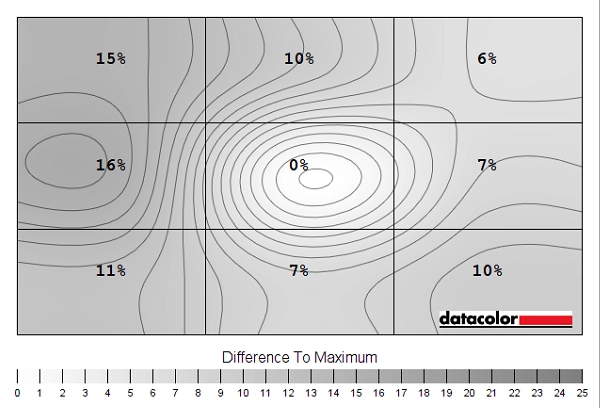
Luminance uniformity map
Contrast in games and movies
Lagom contrast tests
Colour reproduction
Colour gamut
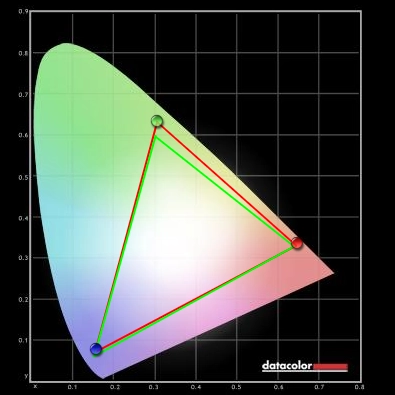
Colour gamut test settings
Colour in games and movies
Viewing angles
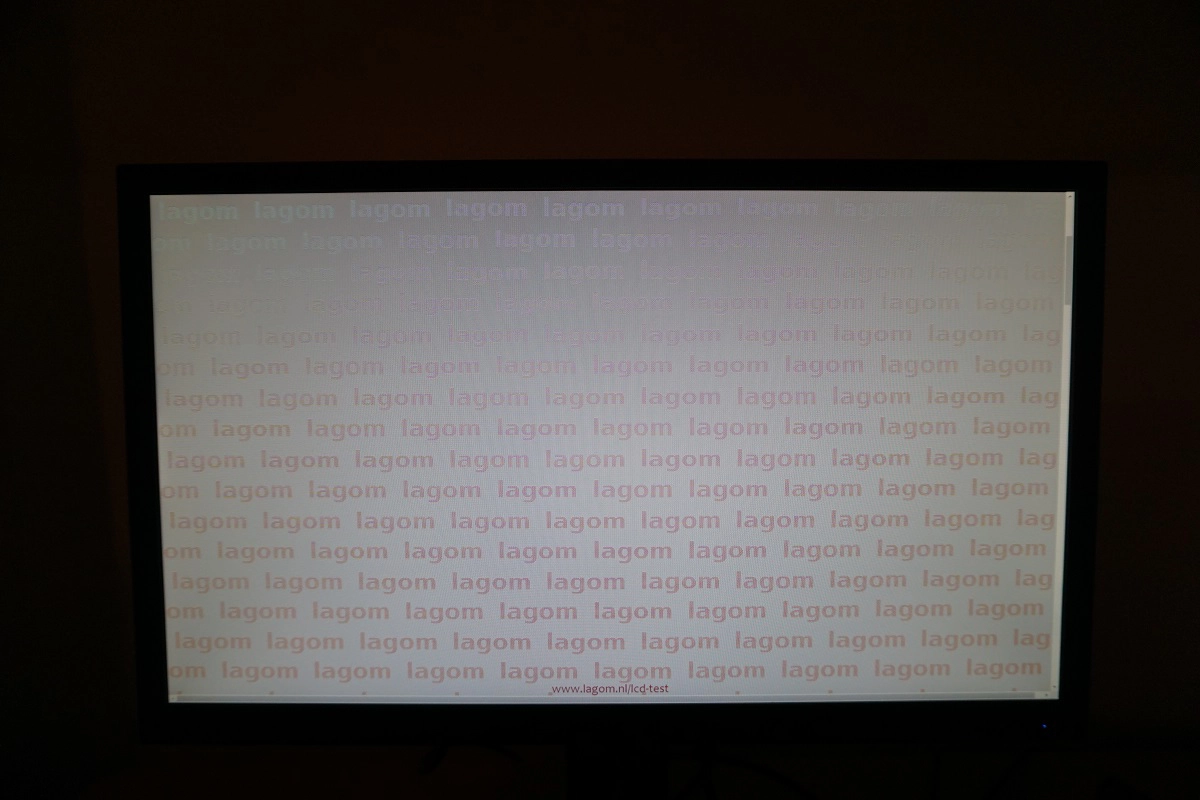
The video below shows the results of the Lagom text test, a mixed desktop background and dark desktop background from a variety of viewing angles. You can see some significant colour and contrast shifts, particularly vertically, and even some colour inversion beyond a certain point for the mixed desktop background. For the dark desktop background you can see a silver or golden sheen that blooms out more noticeably from sharp angles. This could be dubbed ‘TN glow’ and is not visible from a normal viewing position and is never as intense as ‘IPS glow’ from a given viewing position.
Interlace pattern artifacts

Responsiveness
Input lag
Perceived blur (pursuit photography)

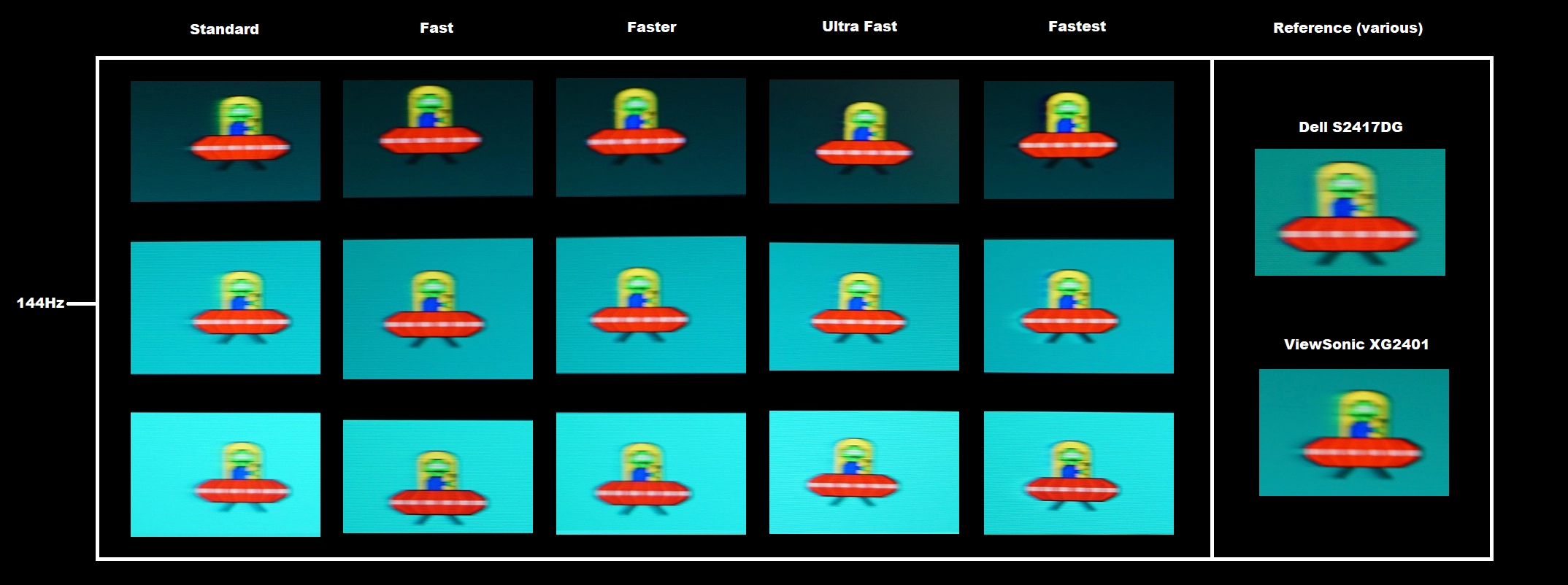
Responsiveness in games and movies

FreeSync – the technology and activating it
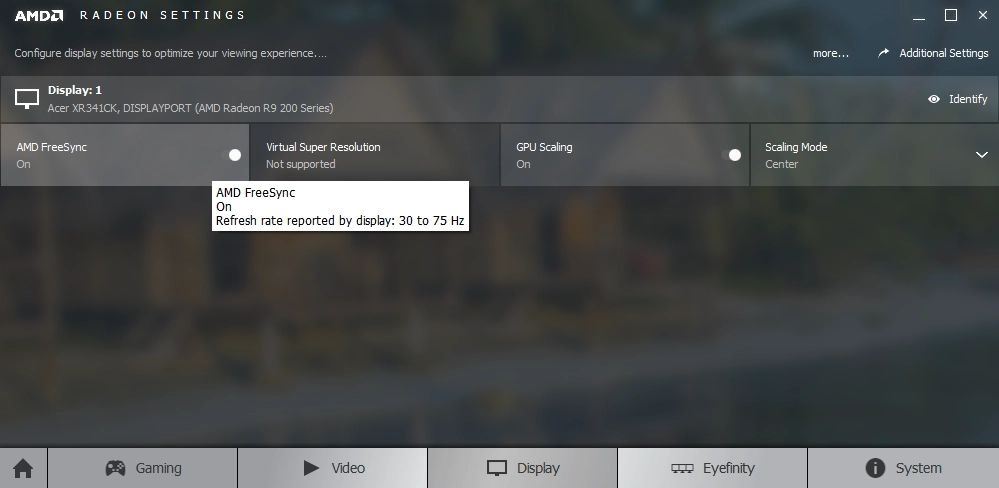
The ViewSonic supports a variable refresh rate range of 48 – 144Hz. That means that if the game is running between 48fps and 144fps, the monitor will adjust its refresh rate to match. When the frame rate rises above 144fps, the monitor will stay at 144Hz and the GPU will respect your selection of ‘VSync on’ or ‘VSync off’ in the graphics driver. With ‘VSync on’ the frame rate will not be allowed to rise above 144fps, at which point VSync activates and imposes the usual associated latency penalty. With ‘VSync off’ the frame rate is free to climb as high as the GPU will output (potentially >144fps). AMD LFC (Low Framerate Compensation) is also supported by this model, which means that the refresh rate will stick to multiples of the frame rate where it falls below the 48Hz (48fps) floor of operation for FreeSync. If a game ran at 36fps, for example, the refresh rate would be 72Hz to help keep tearing and stuttering at bay. This feature is used regardless of VSync setting, so it’s only above the ceiling of operation where the VSync setting makes a difference.
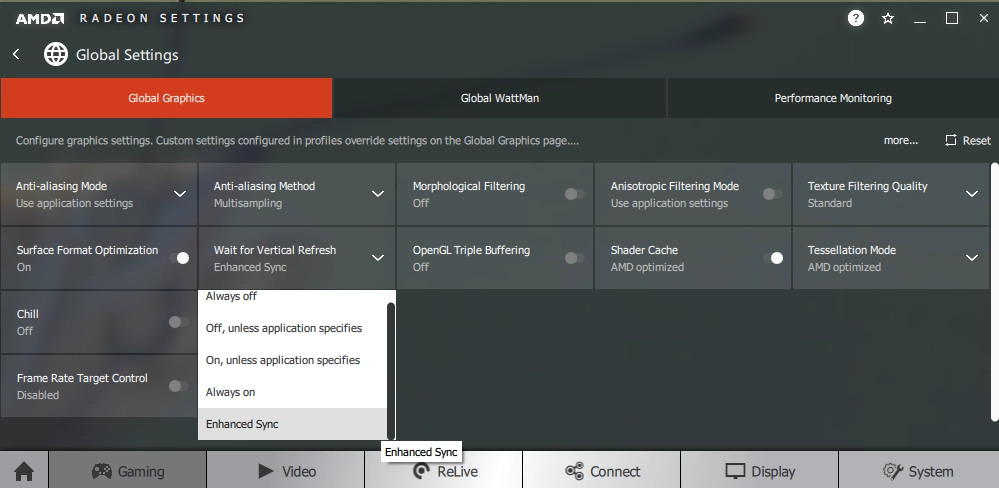
Note that this monitor does not provide any obvious ‘at a glance’ indication that FreeSync is active, such as a change of power LED colour. However; if you go to ‘Setup Menu’ – ‘Information’ in the OSD you can see if FreeSync is working correctly. If you see the ‘V. Frequency’ change alongside the frame rate, then it’s working properly. If it just stays at the static refresh rate that you set, then it’s because the technology isn’t active. This could be because you haven’t configured it properly in the driver or that the frame rate is simply beyond the ceiling for FreeSync operation (i.e. 144fps+). Finally, it’s worth remembering FreeSync only removes stuttering or juddering related to mismatches between frame rate and refresh rate. It can’t compensate for other interruptions to smooth game play, for example network latency or insufficient system memory.
FreeSync – the experience
Video review
Conclusion
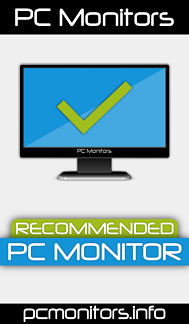
Positives Negatives Excellent OSD flexibility allowing appropriate gamma handling to be achieved with OSD tweaks alone The usual TN viewing angle limitations, affecting colour consistency perceived gamma and saturation levels when viewing different sections of the screen
No ‘IPS glow’ to contend with, aiding detail levels peripherally and keeping away that associated ‘bottom corner bloom’ that some users really dislike Significant static contrast weaknesses on our unit. The perceived gamma changes affect visibility in dark areas at different points of the screen. The slightly grainy screen surface also affected the apparent clarity of lighter shades Excellent responsiveness, with well-tuned pixel overdrive and low input lag providing a pleasing 144Hz performance for both Nvidia and AMD users. The latter group also benefit from FreeSync, which worked as it should on this model
Some models provide support for even higher refresh rates (although that comes at a premium) A pretty unfussy appearance, good ergonomic flexibility and a reasonable selection of ports (including HDMI with FreeSync support)
The 1920 x 1080 (FHD) resolution is the bottom rung of the resolution ladder for modern screens of this size – but one many users will be perfectly comfortable with
As an Amazon Associate I earn from qualifying purchases made using the below link. Where possible, you’ll be redirected to your nearest store. Further information on supporting our work.


